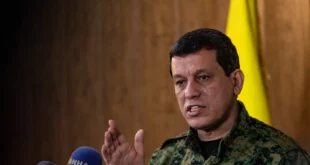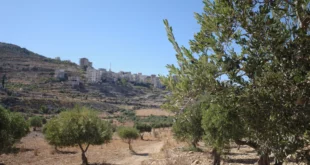Analysis: After Israel’s strikes last year and amid heightened tensions with the US, do Iran’s air defence capabilities still pack a punch?
Amid heightened tensions with the United States, Iran has sought to emphasise the effectiveness of its air defences, which Israel hit with deadly airstrikes in October. Whether this is an attempt to save face on Tehran’s part or an objective reality is unclear.
“The Armed Forces of the Islamic Republic of Iran, particularly the powerful Air Defence Force, are more prepared than ever and maintain a high level of combat readiness,” stressed Alireza Sabahifard, commander of the Iranian military’s Air Defence Force and the Khatam al-Anbiya Air Defence Base in early April.
Two days earlier, Sabahifard boasted that Iran’s “air defence prowess” was “standing firmly like a mountain” against potential threats.
He made the statements amid a standoff between Iran and the Trump administration over the former’s nuclear program. President Trump gave Tehran a two-month deadline to negotiate over the future of its nuclear program directly.
Washington has sent additional air defences to the region and forward-deployed strategic B-2 Spirit stealth bombers, the only aircraft capable of carrying bombs that could significantly damage Iran’s underground nuclear sites, on Diego Garcia in the Indian Ocean.
Amidst this buildup, it’s unsurprising that Iran would seek to reassure the public about its air defence capabilities. However, it’s not the only reason it is doing so.
On 26 October, Israel launched a devastating campaign of air and drone strikes against strategic Iranian targets, including air defences. Israel boasted that the raid destroyed Iran’s strategic Russian-built long-range S-300 air defence missile systems. Israel also targeted an S-300 radar in a strike on Isfahan on 19 April 2024.
Tehran has understandably attempted to downplay the significance of these strikes. In early February, Iranian media showcased an S-300 launcher for the first time since the October raid in an air defence exercise.
Iran notably integrated the S-300 with an indigenous Iranian-built Bavar-373, which Tehran claims is in the same league as the strategic Russian systems.
Air Defence Force commander Sabahifard said in February that Iran’s air defences are “100% homegrown,” citing the Bavar-373 as “a prime example.”
Amir-Ali Hajizadeh, commander of the powerful Islamic Revolutionary Guard Corps paramilitary’s Aerospace Forces, acknowledged on 18 February that Iran’s “anti-ballistic defence” systems suffered damage in “recent incidents.”
That same day, the Iranian armed forces chief of staff, Mohammad Bagheri, claimed Iran’s air defence is “at the height of readiness, and the minor damage inflicted on it has been completely repaired.”
Seven senior Russian military officials specialising in missiles visited Iran in 2024, two of whom were air defence missile experts, Reuters reported in March. It’s unclear whether those visiting Russian military officials helped Iran repair any S-300s. Additionally, Russia reportedly began delivering radars and unspecified air defence equipment to Iran last August, between the two Israeli attacks.
“I have not heard or seen anything to suggest Russia has done anything to replace the batteries destroyed by the Israeli strikes,” James Devine, associate professor in the Department of Politics and International Relations at Mount Allison University, told The New Arab.
“However, based on the coverage of Iran’s military exercises, it would indeed appear that Iran still has some components of the S-300 batteries operational.”
Iranian engineers may have found some way to integrate the Bavar-373 radar with the S-300 launcher. It’s conceivable that Israeli strikes launched at standoff ranges solely targeted the system’s radars, as was the case in April, leaving other components like launchers intact.
Devine pointed out that each S-300 comprises four components: an engagement radar, an early warning acquisition radar, launcher vehicles, and command and control.
“The new integrated system may include components that survived. Or, it may also be that Iran is using older missiles,” he said. “They upgraded from the 48N6E2 to the 48N6DM missiles a few years back, so perhaps some of the older ones are being put back in the front line.”
Federico Borsari, a defence expert at the Centre for European Policy Analysis, said “solid intelligence” indicates that Iran’s air defences sustained significant damage, especially the S-300 radars.
“While the Russian officials’ visits obviously corroborate evidence of robust military cooperation, the extent and scope of such assistance remain uncertain,” Borsari told TNA.
“It’s also possible that Iranian technicians are seeking advice from Russia on how to increase the survivability and resilience of their S-300s and, more generally, to help discern Israel’s potential attack plans.”
He noted that Iran has “demonstrated substantial interest” in integrating its indigenous Bavar-373 with the S-300 to “increase the redundancy” of its integrated air and missile defence.
“In other words, if the S-300 is damaged or attrited in a potential attack, the Bavar 373 could replace it or alternatively be used in combination,” Borsari said.
“Depending on the extent of integration, it is plausible that Iran could offset the loss of the S-300’s 30N6E2 Tombstone fire-control radar by using both the 64N6 volume search/sector scan radar and 96L6E acquisition radar to support the Bavar’s illuminator unit to lock on the target.”
Devine also doesn’t think it’s surprising that Iran would try to “patch together” its remaining air defences.
“Iran’s air defence system is a layered system with multiple systems, at least in theory, coordinated to deal with multiple targets of different sizes, operating at different altitudes and ranges,” he said.
Therefore, there has always been some capacity for integrating command and control across various systems, according to Devine.
“Also, from what I have read, the S-300s can network with the other types of systems the Iranians use, particularly the components that are also Russian-built, but also some of the indigenous systems,” he said.
“Since the Bavar-373 and the S-300s would both be used by Iran to intercept high-altitude targets, a system made up of the two could conceivably be put together to fill that role in the Iranian air defence network previously played by the S-300s alone,” the expert added.
“If the integrated system is just a publicity stunt, which is entirely possible, the 373s would be tasked with doing that job alone.”
Borsari pointed to military exercises in which Iranian forces “effectively employed both systems” in a demonstration of operational coordination, suggesting that Tehran aims to bolster self-sufficiency by developing a “hybridised defence network” rather than relying solely on Russian technologies.
“However, I have also seen scepticism regarding whether such integration significantly enhances Iran’s capacity to address modern aerial threats,” he said. “While the Bavar-373 has been boasted to possess capabilities on par with advanced systems like the S-300, independent assessments often suggest otherwise. So, on this, I remain cautious based on the fragmentary evidence that we have.”
Devine is similarly sceptical. He questioned how well these integrated systems would fare in real-world conditions compared to a controlled exercise.
“Iran announced upgrades to the Bavar-373s in the Fall of last year and again in February, but their actual capabilities are uncertain,” he said. “I doubt the February upgrades will be enough to plug the holes evident in Iran’s air defence last year.”
Iran claims the Bavar-373 has an engagement range of up to 186 miles. However, that has not been combat-proven as of writing, nor is it clear how the Iranian-made system would fare against enemy ballistic missiles. Israel used a number of air-launched ballistic missiles in both its extensive October strikes and lone April pinprick attack.
“In general, the current state of Iranian air defences, primarily the Bavar-373 in conjunction with other systems, does complicate potential Israeli or joint US-Israeli military operations aimed at Tehran’s nuclear facilities,” Borsari said.
“Despite the doubts surrounding the Bavar-373’s effectiveness, its hybridisation with older systems like the S-300 may provide Iran with a multi-layered defence that can create operational challenges for any attacking force.”
 Eurasia Press & News
Eurasia Press & News



